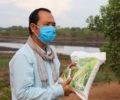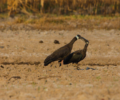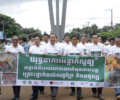Crane Rice” – an initiative to improve local livelihoods and conserve the threatened Sarus Crane in Cambodia

“The Ministry of Environment, in collaboration with NatureLife Cambodia and BirdLife International, and supported by IUCN-Netherlands, has now established a new ‘Crane Rice’ initiative, aimed at improving local livelihoods and better conserving the stately Sarus Crane. ‘Crane Rice’ will involves wildlife-friendly rice farming practices which will benefit the cranes and other waterbirds in Cambodia. The Eastern Sarus Crane (Antigone antigone sharpii) is the only resident crane in Southeast Asia and is globally threatened under the IUCN Red List,” said H.E. Neth Pheaktra, Secretary of State and the spokesperson for the Ministry of Environment on 23 July 2021 during a field visit to the Anlung Pring Protected landscape in Boeung Salang Kang Tbaung and Prek Kruss communes, Kampong Trach district, in Kampot Province. H.E. Neth Pheaktra added, “Under this initiative, participating farmers need to grow native and crane-preferred rice varieties. They also need to adhere to the guidelines for crane rice. This means that the farmers cannot hunt and snare wildlife on their plots, and apply poisons. Farmers are also expected to avoid encroaching on protected lands and work towards organically grown rice (i.e. no application of chemicals fertilizers and herbicides). Half of the rice grown on leased land, will be harvested and packaged for sale while the remainder will be left in the fields to benefit Sarus Cranes and other biodiversity”. “For crane conservation and protection to be successful, it needs to consider local livelihoods and engagement with stakeholders. The Ministry of Environment will continue to collaborate with our NGO partners to find markets for Crane Rice to ensure the success of the pilot programmes, while encouraging farmers to participate in this initiative and working to ensure that the rice can be sold at a premium”, H.E. Neth Pheaktra noted. Mr. Bou Vorsak, the acting chief executive officer for NatureLife Cambodia and programme manager for BirdLife International in Cambodia indicated, “to manage and maintain the Anlung Pring protected landscape for long-term conservation of our Sarus Crane, we need to ensure that the rice fields located around this protected area provide food and a safe haven for the cranes. Since its inception, we have collaborated with 16 farmers and over 10 years, leased 17 hectares of rice fields to pilot work to grow crane-friendly rice, thereby benefiting local livelihoods”. Mr. Vorsak added, “The number of farmers who have participated in our Crane rice initiative is increasing this year, which is very welcome.”Mr. Marc Hoogeslag, the programme coordinator of IUCN-Netherlands, said that, “to reduce the pressures on our natural resources, we need to find a balance between the needs of people and wildlife. This initiative for Sarus Crane rice in the Anlung Pring Protected Landscape is a great example of mutual coexistence between local people, in this case rice farmers, and an amazing migratory bird species that is otherwise facing serious threats in Southeast Asia.” Mr. Suy Thear, Director of Kampot’s Provincial Department of the Environment, said that “our Department remains committed to protecting biodiversity in the Anlung Pring protected landscape. Our permanently based rangers have collaborated with the local authorities and our NGO partners to educate local people about the legislation that protects wildlife and the value of rare bird species, especially the Sarus Crane. The Sarus Crane rice initiative has provided supplementary feeding for the cranes that annually visit our site during their non-breeding season.” Mr. Vann Bora, Boeung Salang Kang Tbaung Commune Chief, said that, “I strongly support this project and hope that my commune will become a landscape where our Sarus Crane can continue to use in the future.” Mr. Teup Khay, a farmer from Kok Chamkar, said that, “I joined the Sarus Crane rice pilot project as it provided me with additional income. At the same time, I am happy that growing rice without the use of chemical fertilizers and pesticides can help provide safer food for the Sarus Crane, which we are very proud of. If our cranes are better conserved, it will also help to draw more tourists to see them, and enjoy the culture and hospitality of our communities.” Based on the findings of the 2020 Sarus Crane census in Cambodia, only 194 birds have been recorded, an all-time low. In the last few years, the number of cranes has declined steadily due to the high mortality rate and low nesting success in its breeding grounds. Additional threats faced by the cranes include deteriorating habitat conditions, poisoning caused by pesticide use, lack of food, change in water regimes at key wetlands, diseases, and in the long-term, climate change.
Tagged:



